Money, Banking, and Finance: Yield Curve, Financial Intermediaries
VerifiedAdded on 2023/06/14
|16
|4024
|327
Report
AI Summary
This report provides a detailed analysis of key concepts in money, banking, and finance. It begins with an overview of Net Present Value (NPV) and Internal Rate of Return (IRR) for project evaluation, followed by an explanation of how Yield to Maturity (YTM) is used to calculate yield curves and why investors track these movements. The report further explores the role and functions of financial intermediaries within the financial system, highlighting both their positive and negative impacts. Finally, it examines the factors that determine the time lag between the application of monetary policy instruments and the achievement of desired economic goals, including a discussion of the transmission mechanism of monetary policy. The document is a student contributed assignment to be published on Desklib, a platform with study tools for students.
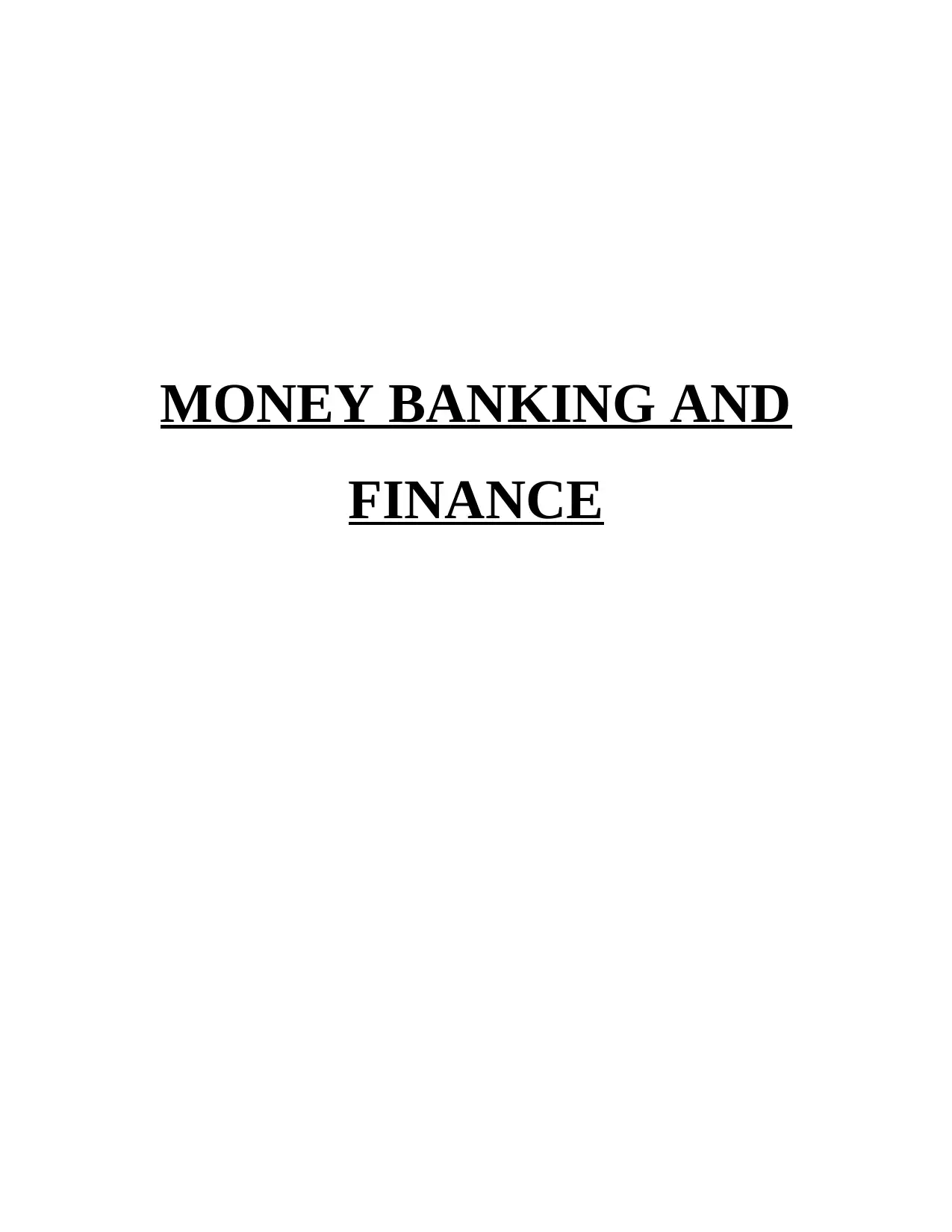
MONEY BANKING AND
FINANCE
FINANCE
Paraphrase This Document
Need a fresh take? Get an instant paraphrase of this document with our AI Paraphraser
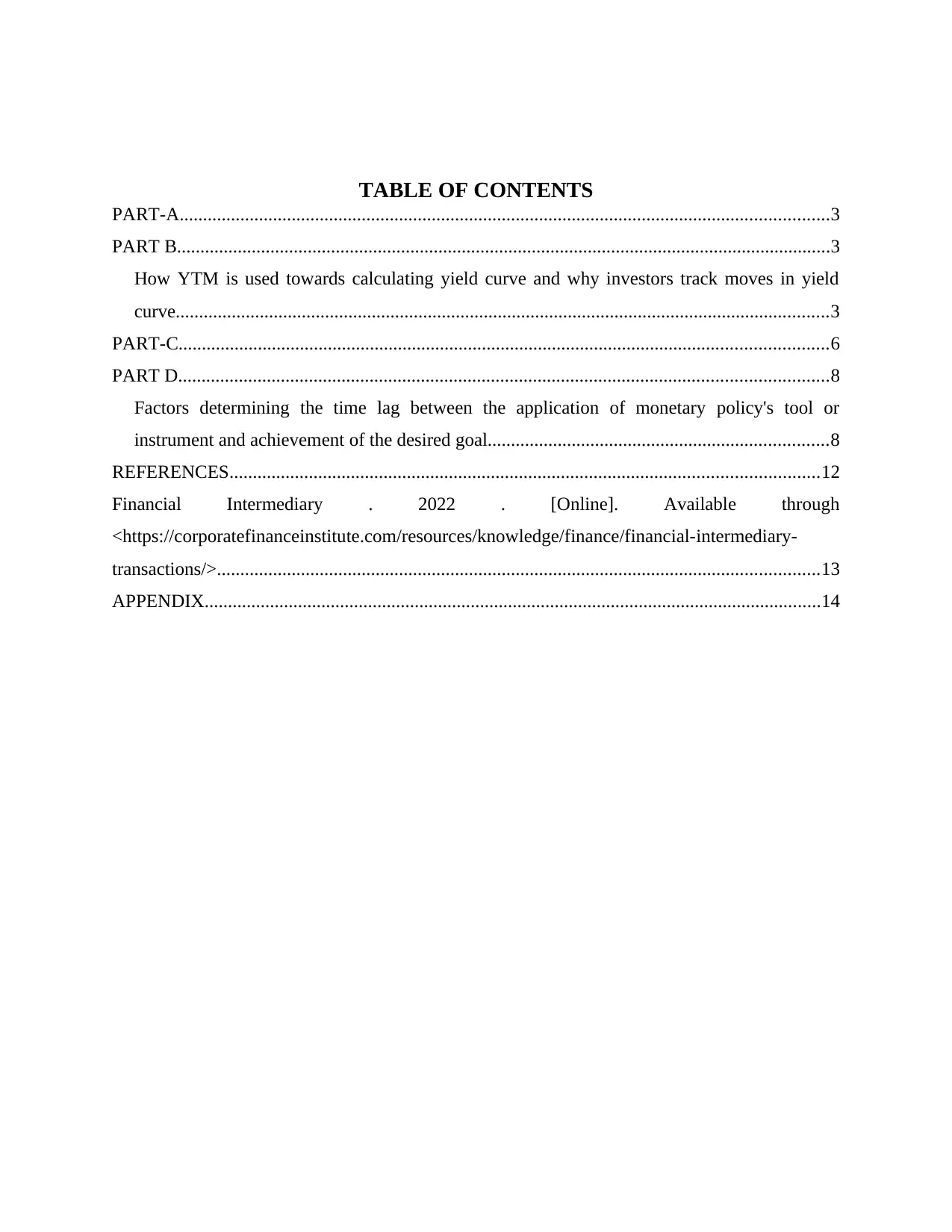
TABLE OF CONTENTS
PART-A...........................................................................................................................................3
PART B............................................................................................................................................3
How YTM is used towards calculating yield curve and why investors track moves in yield
curve............................................................................................................................................3
PART-C...........................................................................................................................................6
PART D...........................................................................................................................................8
Factors determining the time lag between the application of monetary policy's tool or
instrument and achievement of the desired goal.........................................................................8
REFERENCES..............................................................................................................................12
Financial Intermediary . 2022 . [Online]. Available through
<https://corporatefinanceinstitute.com/resources/knowledge/finance/financial-intermediary-
transactions/>.................................................................................................................................13
APPENDIX....................................................................................................................................14
PART-A...........................................................................................................................................3
PART B............................................................................................................................................3
How YTM is used towards calculating yield curve and why investors track moves in yield
curve............................................................................................................................................3
PART-C...........................................................................................................................................6
PART D...........................................................................................................................................8
Factors determining the time lag between the application of monetary policy's tool or
instrument and achievement of the desired goal.........................................................................8
REFERENCES..............................................................................................................................12
Financial Intermediary . 2022 . [Online]. Available through
<https://corporatefinanceinstitute.com/resources/knowledge/finance/financial-intermediary-
transactions/>.................................................................................................................................13
APPENDIX....................................................................................................................................14
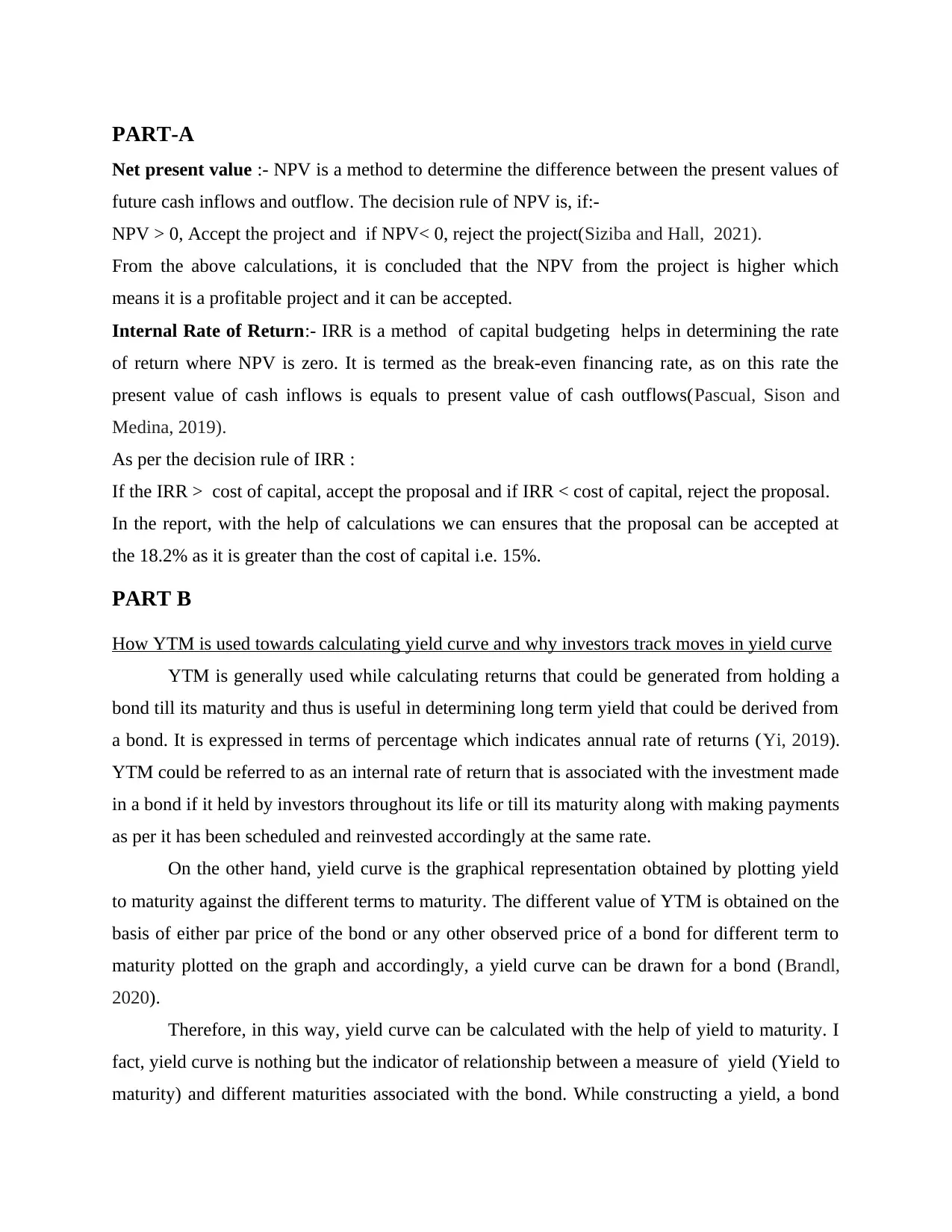
PART-A
Net present value :- NPV is a method to determine the difference between the present values of
future cash inflows and outflow. The decision rule of NPV is, if:-
NPV > 0, Accept the project and if NPV< 0, reject the project(Siziba and Hall, 2021).
From the above calculations, it is concluded that the NPV from the project is higher which
means it is a profitable project and it can be accepted.
Internal Rate of Return:- IRR is a method of capital budgeting helps in determining the rate
of return where NPV is zero. It is termed as the break-even financing rate, as on this rate the
present value of cash inflows is equals to present value of cash outflows(Pascual, Sison and
Medina, 2019).
As per the decision rule of IRR :
If the IRR > cost of capital, accept the proposal and if IRR < cost of capital, reject the proposal.
In the report, with the help of calculations we can ensures that the proposal can be accepted at
the 18.2% as it is greater than the cost of capital i.e. 15%.
PART B
How YTM is used towards calculating yield curve and why investors track moves in yield curve
YTM is generally used while calculating returns that could be generated from holding a
bond till its maturity and thus is useful in determining long term yield that could be derived from
a bond. It is expressed in terms of percentage which indicates annual rate of returns (Yi, 2019).
YTM could be referred to as an internal rate of return that is associated with the investment made
in a bond if it held by investors throughout its life or till its maturity along with making payments
as per it has been scheduled and reinvested accordingly at the same rate.
On the other hand, yield curve is the graphical representation obtained by plotting yield
to maturity against the different terms to maturity. The different value of YTM is obtained on the
basis of either par price of the bond or any other observed price of a bond for different term to
maturity plotted on the graph and accordingly, a yield curve can be drawn for a bond (Brandl,
2020).
Therefore, in this way, yield curve can be calculated with the help of yield to maturity. I
fact, yield curve is nothing but the indicator of relationship between a measure of yield (Yield to
maturity) and different maturities associated with the bond. While constructing a yield, a bond
Net present value :- NPV is a method to determine the difference between the present values of
future cash inflows and outflow. The decision rule of NPV is, if:-
NPV > 0, Accept the project and if NPV< 0, reject the project(Siziba and Hall, 2021).
From the above calculations, it is concluded that the NPV from the project is higher which
means it is a profitable project and it can be accepted.
Internal Rate of Return:- IRR is a method of capital budgeting helps in determining the rate
of return where NPV is zero. It is termed as the break-even financing rate, as on this rate the
present value of cash inflows is equals to present value of cash outflows(Pascual, Sison and
Medina, 2019).
As per the decision rule of IRR :
If the IRR > cost of capital, accept the proposal and if IRR < cost of capital, reject the proposal.
In the report, with the help of calculations we can ensures that the proposal can be accepted at
the 18.2% as it is greater than the cost of capital i.e. 15%.
PART B
How YTM is used towards calculating yield curve and why investors track moves in yield curve
YTM is generally used while calculating returns that could be generated from holding a
bond till its maturity and thus is useful in determining long term yield that could be derived from
a bond. It is expressed in terms of percentage which indicates annual rate of returns (Yi, 2019).
YTM could be referred to as an internal rate of return that is associated with the investment made
in a bond if it held by investors throughout its life or till its maturity along with making payments
as per it has been scheduled and reinvested accordingly at the same rate.
On the other hand, yield curve is the graphical representation obtained by plotting yield
to maturity against the different terms to maturity. The different value of YTM is obtained on the
basis of either par price of the bond or any other observed price of a bond for different term to
maturity plotted on the graph and accordingly, a yield curve can be drawn for a bond (Brandl,
2020).
Therefore, in this way, yield curve can be calculated with the help of yield to maturity. I
fact, yield curve is nothing but the indicator of relationship between a measure of yield (Yield to
maturity) and different maturities associated with the bond. While constructing a yield, a bond
⊘ This is a preview!⊘
Do you want full access?
Subscribe today to unlock all pages.

Trusted by 1+ million students worldwide

belonging from a homogenous group could only be included such as bond having similar degree
of liquidity and same level or class of risk. Accordingly, corporate and government bonds could
not be taken together as the risk class differs for these two types of bonds.
The most common yield curve that investors popularly uses to track the moves in yield
curve is the yield to maturity yield curve (Haseeb, 2018). On single yield curve, number of YTM
can be plotted associated with different bonds but there is a prior condition that bonds from a
similar class could be plotted on a single yield curve. On the x-axis of the yield curve different
term to maturities are plotted while on the y-axis yield to maturity associated with different term
to maturities are plotted.
However, there is a problem linked with the YTM yield curve due to the assumption that
whatever coupon payments derived from a bond could be reinvested at the YTM, but as the
interest rates in the market gets changed over time it is not possible to reinvest at YTM and
accordingly, it leads to reinvestment risk. Also, it has been argued with reference to payments
made on a bond is that the discounting does not take place at an appropriate rate of interest. Due
to reasons investors and bond analysts avoid using yield curve derived on the basis of yield to
maturity and accordingly, have derived various other types of yield curves such as coupon yield
curve, par yield curve or a zero – coupon yield curve (Feng, Luetkebohmert and Xiao, 2019).
Calculation of yield curve on the basis of yield to maturity
For example, a yield curve could be obtained for a Treasury bond which is calculated on the
basis of following terms to maturity and yields to maturity.
Maturity Yield to maturity (%)
1-Month 0.18
3-Months 0.27
6-Months 0.48
1 Year 0.66
2 Years 0.92
3 Years 1.28
5 Years 1.86
10 Years 2.72
of liquidity and same level or class of risk. Accordingly, corporate and government bonds could
not be taken together as the risk class differs for these two types of bonds.
The most common yield curve that investors popularly uses to track the moves in yield
curve is the yield to maturity yield curve (Haseeb, 2018). On single yield curve, number of YTM
can be plotted associated with different bonds but there is a prior condition that bonds from a
similar class could be plotted on a single yield curve. On the x-axis of the yield curve different
term to maturities are plotted while on the y-axis yield to maturity associated with different term
to maturities are plotted.
However, there is a problem linked with the YTM yield curve due to the assumption that
whatever coupon payments derived from a bond could be reinvested at the YTM, but as the
interest rates in the market gets changed over time it is not possible to reinvest at YTM and
accordingly, it leads to reinvestment risk. Also, it has been argued with reference to payments
made on a bond is that the discounting does not take place at an appropriate rate of interest. Due
to reasons investors and bond analysts avoid using yield curve derived on the basis of yield to
maturity and accordingly, have derived various other types of yield curves such as coupon yield
curve, par yield curve or a zero – coupon yield curve (Feng, Luetkebohmert and Xiao, 2019).
Calculation of yield curve on the basis of yield to maturity
For example, a yield curve could be obtained for a Treasury bond which is calculated on the
basis of following terms to maturity and yields to maturity.
Maturity Yield to maturity (%)
1-Month 0.18
3-Months 0.27
6-Months 0.48
1 Year 0.66
2 Years 0.92
3 Years 1.28
5 Years 1.86
10 Years 2.72
Paraphrase This Document
Need a fresh take? Get an instant paraphrase of this document with our AI Paraphraser
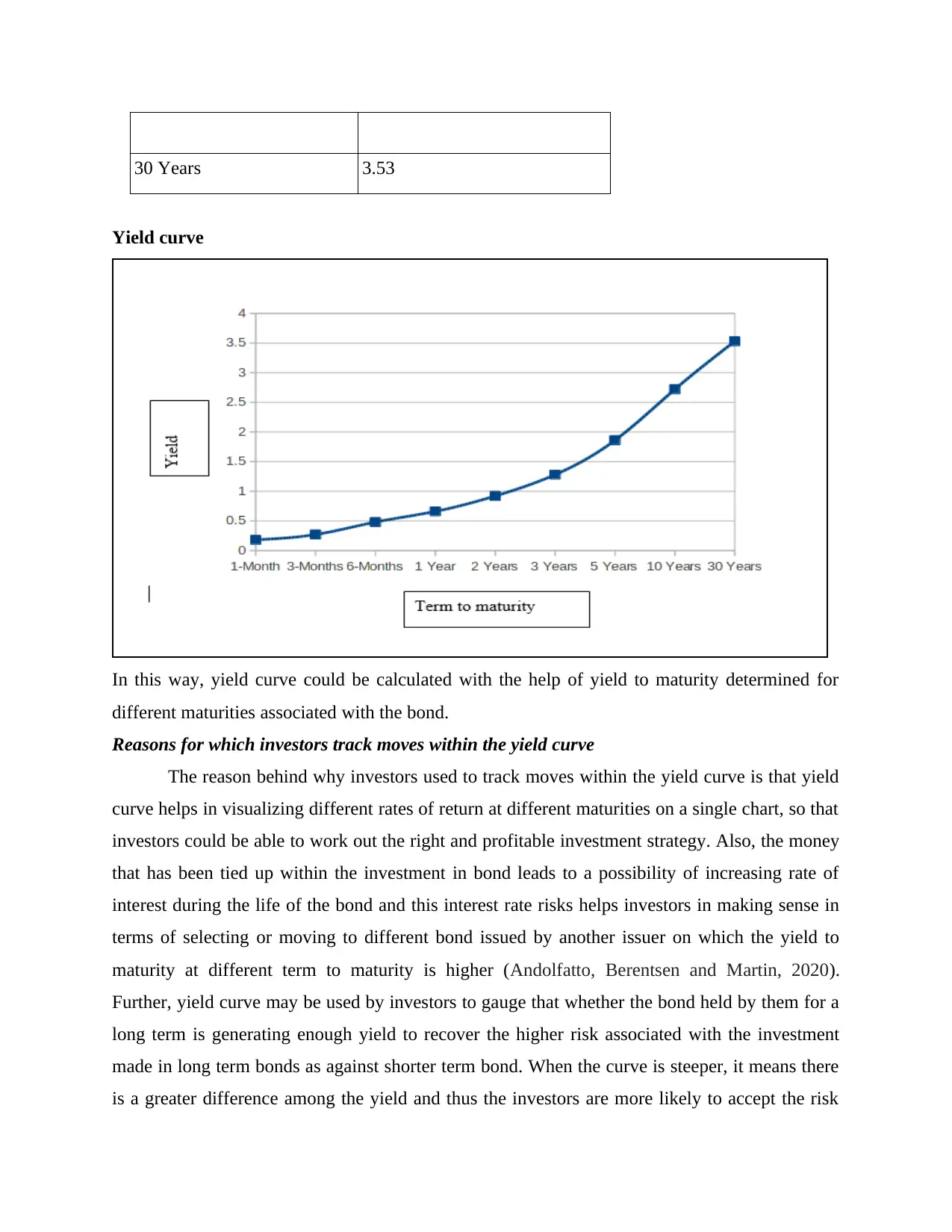
30 Years 3.53
Yield curve
In this way, yield curve could be calculated with the help of yield to maturity determined for
different maturities associated with the bond.
Reasons for which investors track moves within the yield curve
The reason behind why investors used to track moves within the yield curve is that yield
curve helps in visualizing different rates of return at different maturities on a single chart, so that
investors could be able to work out the right and profitable investment strategy. Also, the money
that has been tied up within the investment in bond leads to a possibility of increasing rate of
interest during the life of the bond and this interest rate risks helps investors in making sense in
terms of selecting or moving to different bond issued by another issuer on which the yield to
maturity at different term to maturity is higher (Andolfatto, Berentsen and Martin, 2020).
Further, yield curve may be used by investors to gauge that whether the bond held by them for a
long term is generating enough yield to recover the higher risk associated with the investment
made in long term bonds as against shorter term bond. When the curve is steeper, it means there
is a greater difference among the yield and thus the investors are more likely to accept the risk
Yield curve
In this way, yield curve could be calculated with the help of yield to maturity determined for
different maturities associated with the bond.
Reasons for which investors track moves within the yield curve
The reason behind why investors used to track moves within the yield curve is that yield
curve helps in visualizing different rates of return at different maturities on a single chart, so that
investors could be able to work out the right and profitable investment strategy. Also, the money
that has been tied up within the investment in bond leads to a possibility of increasing rate of
interest during the life of the bond and this interest rate risks helps investors in making sense in
terms of selecting or moving to different bond issued by another issuer on which the yield to
maturity at different term to maturity is higher (Andolfatto, Berentsen and Martin, 2020).
Further, yield curve may be used by investors to gauge that whether the bond held by them for a
long term is generating enough yield to recover the higher risk associated with the investment
made in long term bonds as against shorter term bond. When the curve is steeper, it means there
is a greater difference among the yield and thus the investors are more likely to accept the risk
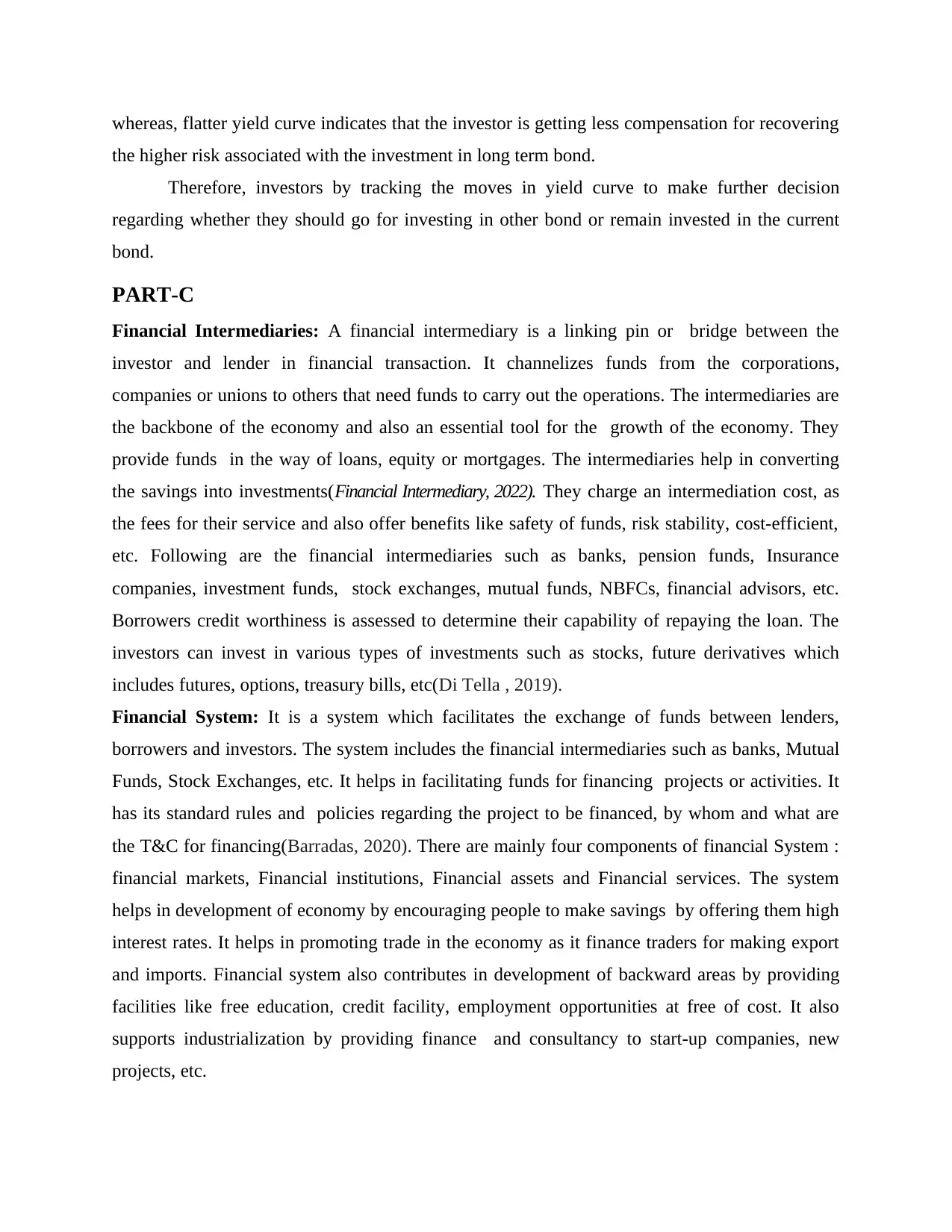
whereas, flatter yield curve indicates that the investor is getting less compensation for recovering
the higher risk associated with the investment in long term bond.
Therefore, investors by tracking the moves in yield curve to make further decision
regarding whether they should go for investing in other bond or remain invested in the current
bond.
PART-C
Financial Intermediaries: A financial intermediary is a linking pin or bridge between the
investor and lender in financial transaction. It channelizes funds from the corporations,
companies or unions to others that need funds to carry out the operations. The intermediaries are
the backbone of the economy and also an essential tool for the growth of the economy. They
provide funds in the way of loans, equity or mortgages. The intermediaries help in converting
the savings into investments(Financial Intermediary, 2022). They charge an intermediation cost, as
the fees for their service and also offer benefits like safety of funds, risk stability, cost-efficient,
etc. Following are the financial intermediaries such as banks, pension funds, Insurance
companies, investment funds, stock exchanges, mutual funds, NBFCs, financial advisors, etc.
Borrowers credit worthiness is assessed to determine their capability of repaying the loan. The
investors can invest in various types of investments such as stocks, future derivatives which
includes futures, options, treasury bills, etc(Di Tella , 2019).
Financial System: It is a system which facilitates the exchange of funds between lenders,
borrowers and investors. The system includes the financial intermediaries such as banks, Mutual
Funds, Stock Exchanges, etc. It helps in facilitating funds for financing projects or activities. It
has its standard rules and policies regarding the project to be financed, by whom and what are
the T&C for financing(Barradas, 2020). There are mainly four components of financial System :
financial markets, Financial institutions, Financial assets and Financial services. The system
helps in development of economy by encouraging people to make savings by offering them high
interest rates. It helps in promoting trade in the economy as it finance traders for making export
and imports. Financial system also contributes in development of backward areas by providing
facilities like free education, credit facility, employment opportunities at free of cost. It also
supports industrialization by providing finance and consultancy to start-up companies, new
projects, etc.
the higher risk associated with the investment in long term bond.
Therefore, investors by tracking the moves in yield curve to make further decision
regarding whether they should go for investing in other bond or remain invested in the current
bond.
PART-C
Financial Intermediaries: A financial intermediary is a linking pin or bridge between the
investor and lender in financial transaction. It channelizes funds from the corporations,
companies or unions to others that need funds to carry out the operations. The intermediaries are
the backbone of the economy and also an essential tool for the growth of the economy. They
provide funds in the way of loans, equity or mortgages. The intermediaries help in converting
the savings into investments(Financial Intermediary, 2022). They charge an intermediation cost, as
the fees for their service and also offer benefits like safety of funds, risk stability, cost-efficient,
etc. Following are the financial intermediaries such as banks, pension funds, Insurance
companies, investment funds, stock exchanges, mutual funds, NBFCs, financial advisors, etc.
Borrowers credit worthiness is assessed to determine their capability of repaying the loan. The
investors can invest in various types of investments such as stocks, future derivatives which
includes futures, options, treasury bills, etc(Di Tella , 2019).
Financial System: It is a system which facilitates the exchange of funds between lenders,
borrowers and investors. The system includes the financial intermediaries such as banks, Mutual
Funds, Stock Exchanges, etc. It helps in facilitating funds for financing projects or activities. It
has its standard rules and policies regarding the project to be financed, by whom and what are
the T&C for financing(Barradas, 2020). There are mainly four components of financial System :
financial markets, Financial institutions, Financial assets and Financial services. The system
helps in development of economy by encouraging people to make savings by offering them high
interest rates. It helps in promoting trade in the economy as it finance traders for making export
and imports. Financial system also contributes in development of backward areas by providing
facilities like free education, credit facility, employment opportunities at free of cost. It also
supports industrialization by providing finance and consultancy to start-up companies, new
projects, etc.
⊘ This is a preview!⊘
Do you want full access?
Subscribe today to unlock all pages.

Trusted by 1+ million students worldwide
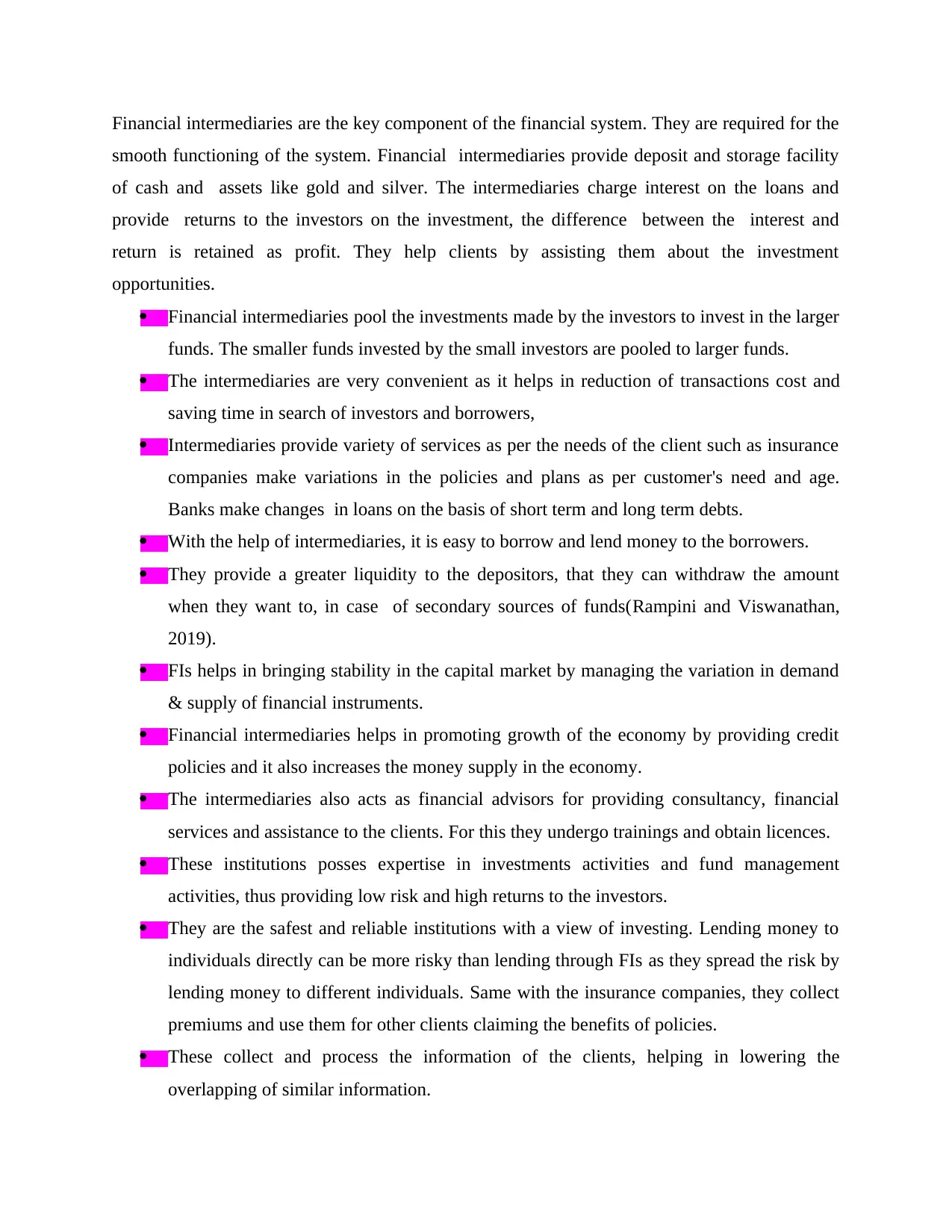
Financial intermediaries are the key component of the financial system. They are required for the
smooth functioning of the system. Financial intermediaries provide deposit and storage facility
of cash and assets like gold and silver. The intermediaries charge interest on the loans and
provide returns to the investors on the investment, the difference between the interest and
return is retained as profit. They help clients by assisting them about the investment
opportunities.
Financial intermediaries pool the investments made by the investors to invest in the larger
funds. The smaller funds invested by the small investors are pooled to larger funds.
The intermediaries are very convenient as it helps in reduction of transactions cost and
saving time in search of investors and borrowers,
Intermediaries provide variety of services as per the needs of the client such as insurance
companies make variations in the policies and plans as per customer's need and age.
Banks make changes in loans on the basis of short term and long term debts.
With the help of intermediaries, it is easy to borrow and lend money to the borrowers.
They provide a greater liquidity to the depositors, that they can withdraw the amount
when they want to, in case of secondary sources of funds(Rampini and Viswanathan,
2019).
FIs helps in bringing stability in the capital market by managing the variation in demand
& supply of financial instruments.
Financial intermediaries helps in promoting growth of the economy by providing credit
policies and it also increases the money supply in the economy.
The intermediaries also acts as financial advisors for providing consultancy, financial
services and assistance to the clients. For this they undergo trainings and obtain licences.
These institutions posses expertise in investments activities and fund management
activities, thus providing low risk and high returns to the investors.
They are the safest and reliable institutions with a view of investing. Lending money to
individuals directly can be more risky than lending through FIs as they spread the risk by
lending money to different individuals. Same with the insurance companies, they collect
premiums and use them for other clients claiming the benefits of policies.
These collect and process the information of the clients, helping in lowering the
overlapping of similar information.
smooth functioning of the system. Financial intermediaries provide deposit and storage facility
of cash and assets like gold and silver. The intermediaries charge interest on the loans and
provide returns to the investors on the investment, the difference between the interest and
return is retained as profit. They help clients by assisting them about the investment
opportunities.
Financial intermediaries pool the investments made by the investors to invest in the larger
funds. The smaller funds invested by the small investors are pooled to larger funds.
The intermediaries are very convenient as it helps in reduction of transactions cost and
saving time in search of investors and borrowers,
Intermediaries provide variety of services as per the needs of the client such as insurance
companies make variations in the policies and plans as per customer's need and age.
Banks make changes in loans on the basis of short term and long term debts.
With the help of intermediaries, it is easy to borrow and lend money to the borrowers.
They provide a greater liquidity to the depositors, that they can withdraw the amount
when they want to, in case of secondary sources of funds(Rampini and Viswanathan,
2019).
FIs helps in bringing stability in the capital market by managing the variation in demand
& supply of financial instruments.
Financial intermediaries helps in promoting growth of the economy by providing credit
policies and it also increases the money supply in the economy.
The intermediaries also acts as financial advisors for providing consultancy, financial
services and assistance to the clients. For this they undergo trainings and obtain licences.
These institutions posses expertise in investments activities and fund management
activities, thus providing low risk and high returns to the investors.
They are the safest and reliable institutions with a view of investing. Lending money to
individuals directly can be more risky than lending through FIs as they spread the risk by
lending money to different individuals. Same with the insurance companies, they collect
premiums and use them for other clients claiming the benefits of policies.
These collect and process the information of the clients, helping in lowering the
overlapping of similar information.
Paraphrase This Document
Need a fresh take? Get an instant paraphrase of this document with our AI Paraphraser
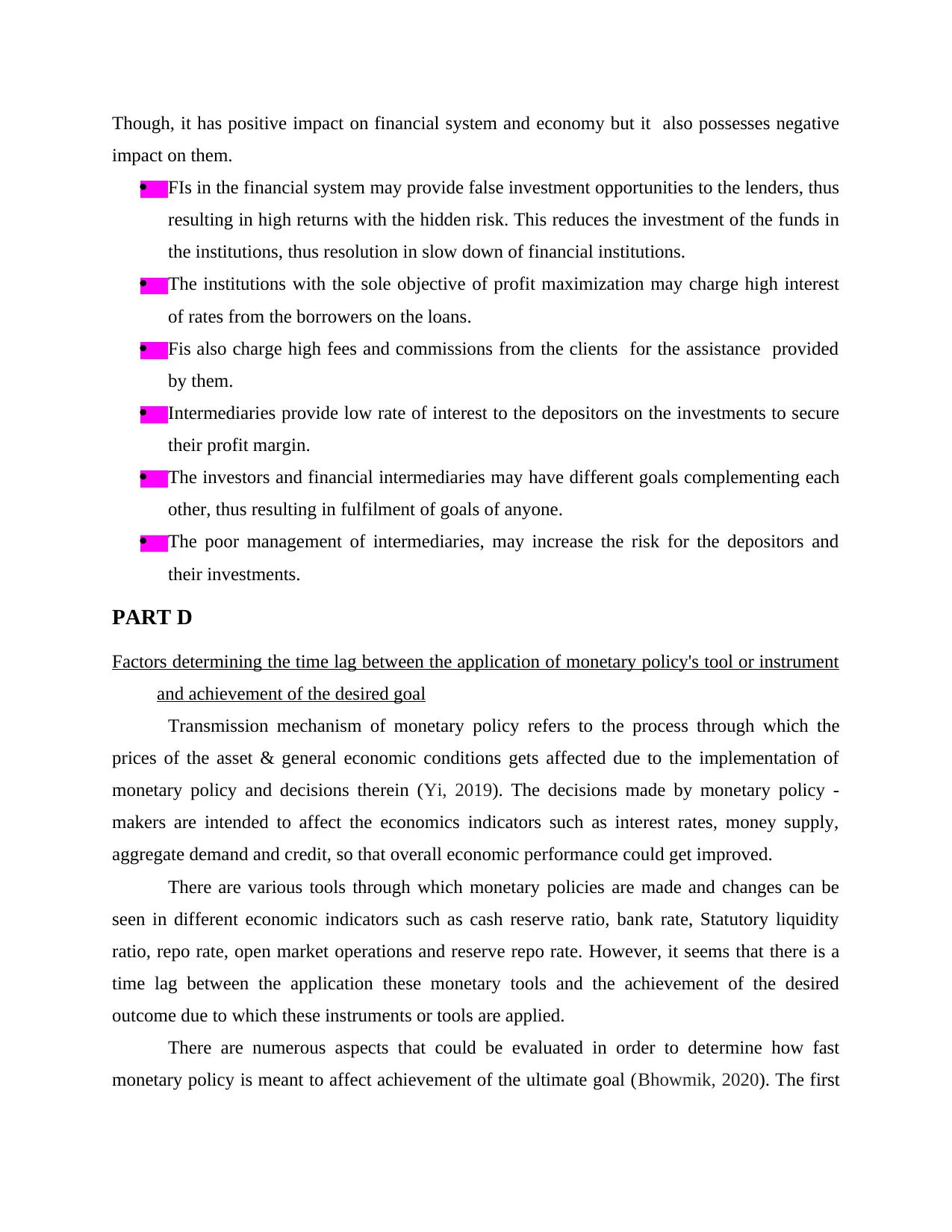
Though, it has positive impact on financial system and economy but it also possesses negative
impact on them.
FIs in the financial system may provide false investment opportunities to the lenders, thus
resulting in high returns with the hidden risk. This reduces the investment of the funds in
the institutions, thus resolution in slow down of financial institutions.
The institutions with the sole objective of profit maximization may charge high interest
of rates from the borrowers on the loans.
Fis also charge high fees and commissions from the clients for the assistance provided
by them.
Intermediaries provide low rate of interest to the depositors on the investments to secure
their profit margin.
The investors and financial intermediaries may have different goals complementing each
other, thus resulting in fulfilment of goals of anyone.
The poor management of intermediaries, may increase the risk for the depositors and
their investments.
PART D
Factors determining the time lag between the application of monetary policy's tool or instrument
and achievement of the desired goal
Transmission mechanism of monetary policy refers to the process through which the
prices of the asset & general economic conditions gets affected due to the implementation of
monetary policy and decisions therein (Yi, 2019). The decisions made by monetary policy -
makers are intended to affect the economics indicators such as interest rates, money supply,
aggregate demand and credit, so that overall economic performance could get improved.
There are various tools through which monetary policies are made and changes can be
seen in different economic indicators such as cash reserve ratio, bank rate, Statutory liquidity
ratio, repo rate, open market operations and reserve repo rate. However, it seems that there is a
time lag between the application these monetary tools and the achievement of the desired
outcome due to which these instruments or tools are applied.
There are numerous aspects that could be evaluated in order to determine how fast
monetary policy is meant to affect achievement of the ultimate goal (Bhowmik, 2020). The first
impact on them.
FIs in the financial system may provide false investment opportunities to the lenders, thus
resulting in high returns with the hidden risk. This reduces the investment of the funds in
the institutions, thus resolution in slow down of financial institutions.
The institutions with the sole objective of profit maximization may charge high interest
of rates from the borrowers on the loans.
Fis also charge high fees and commissions from the clients for the assistance provided
by them.
Intermediaries provide low rate of interest to the depositors on the investments to secure
their profit margin.
The investors and financial intermediaries may have different goals complementing each
other, thus resulting in fulfilment of goals of anyone.
The poor management of intermediaries, may increase the risk for the depositors and
their investments.
PART D
Factors determining the time lag between the application of monetary policy's tool or instrument
and achievement of the desired goal
Transmission mechanism of monetary policy refers to the process through which the
prices of the asset & general economic conditions gets affected due to the implementation of
monetary policy and decisions therein (Yi, 2019). The decisions made by monetary policy -
makers are intended to affect the economics indicators such as interest rates, money supply,
aggregate demand and credit, so that overall economic performance could get improved.
There are various tools through which monetary policies are made and changes can be
seen in different economic indicators such as cash reserve ratio, bank rate, Statutory liquidity
ratio, repo rate, open market operations and reserve repo rate. However, it seems that there is a
time lag between the application these monetary tools and the achievement of the desired
outcome due to which these instruments or tools are applied.
There are numerous aspects that could be evaluated in order to determine how fast
monetary policy is meant to affect achievement of the ultimate goal (Bhowmik, 2020). The first
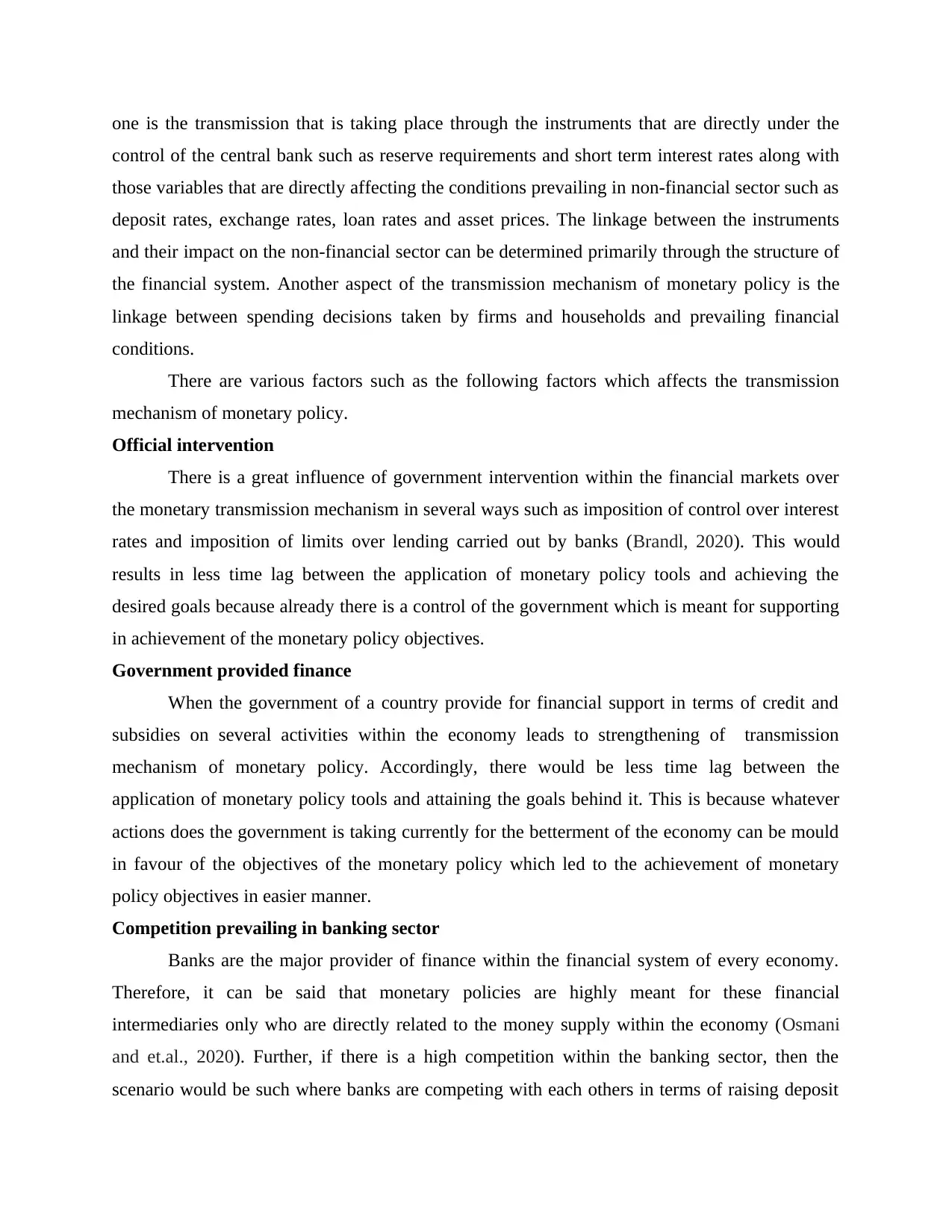
one is the transmission that is taking place through the instruments that are directly under the
control of the central bank such as reserve requirements and short term interest rates along with
those variables that are directly affecting the conditions prevailing in non-financial sector such as
deposit rates, exchange rates, loan rates and asset prices. The linkage between the instruments
and their impact on the non-financial sector can be determined primarily through the structure of
the financial system. Another aspect of the transmission mechanism of monetary policy is the
linkage between spending decisions taken by firms and households and prevailing financial
conditions.
There are various factors such as the following factors which affects the transmission
mechanism of monetary policy.
Official intervention
There is a great influence of government intervention within the financial markets over
the monetary transmission mechanism in several ways such as imposition of control over interest
rates and imposition of limits over lending carried out by banks (Brandl, 2020). This would
results in less time lag between the application of monetary policy tools and achieving the
desired goals because already there is a control of the government which is meant for supporting
in achievement of the monetary policy objectives.
Government provided finance
When the government of a country provide for financial support in terms of credit and
subsidies on several activities within the economy leads to strengthening of transmission
mechanism of monetary policy. Accordingly, there would be less time lag between the
application of monetary policy tools and attaining the goals behind it. This is because whatever
actions does the government is taking currently for the betterment of the economy can be mould
in favour of the objectives of the monetary policy which led to the achievement of monetary
policy objectives in easier manner.
Competition prevailing in banking sector
Banks are the major provider of finance within the financial system of every economy.
Therefore, it can be said that monetary policies are highly meant for these financial
intermediaries only who are directly related to the money supply within the economy (Osmani
and et.al., 2020). Further, if there is a high competition within the banking sector, then the
scenario would be such where banks are competing with each others in terms of raising deposit
control of the central bank such as reserve requirements and short term interest rates along with
those variables that are directly affecting the conditions prevailing in non-financial sector such as
deposit rates, exchange rates, loan rates and asset prices. The linkage between the instruments
and their impact on the non-financial sector can be determined primarily through the structure of
the financial system. Another aspect of the transmission mechanism of monetary policy is the
linkage between spending decisions taken by firms and households and prevailing financial
conditions.
There are various factors such as the following factors which affects the transmission
mechanism of monetary policy.
Official intervention
There is a great influence of government intervention within the financial markets over
the monetary transmission mechanism in several ways such as imposition of control over interest
rates and imposition of limits over lending carried out by banks (Brandl, 2020). This would
results in less time lag between the application of monetary policy tools and achieving the
desired goals because already there is a control of the government which is meant for supporting
in achievement of the monetary policy objectives.
Government provided finance
When the government of a country provide for financial support in terms of credit and
subsidies on several activities within the economy leads to strengthening of transmission
mechanism of monetary policy. Accordingly, there would be less time lag between the
application of monetary policy tools and attaining the goals behind it. This is because whatever
actions does the government is taking currently for the betterment of the economy can be mould
in favour of the objectives of the monetary policy which led to the achievement of monetary
policy objectives in easier manner.
Competition prevailing in banking sector
Banks are the major provider of finance within the financial system of every economy.
Therefore, it can be said that monetary policies are highly meant for these financial
intermediaries only who are directly related to the money supply within the economy (Osmani
and et.al., 2020). Further, if there is a high competition within the banking sector, then the
scenario would be such where banks are competing with each others in terms of raising deposit
⊘ This is a preview!⊘
Do you want full access?
Subscribe today to unlock all pages.

Trusted by 1+ million students worldwide
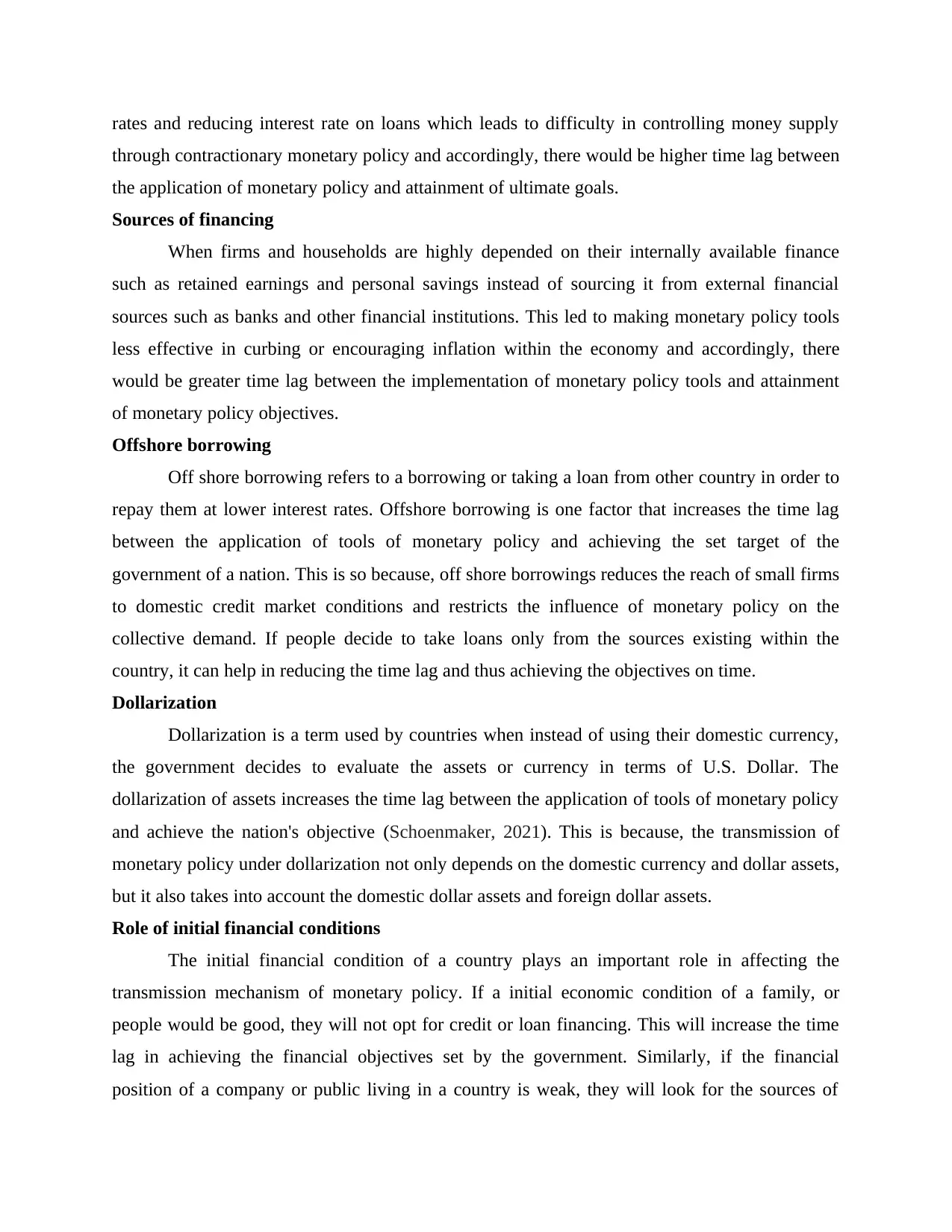
rates and reducing interest rate on loans which leads to difficulty in controlling money supply
through contractionary monetary policy and accordingly, there would be higher time lag between
the application of monetary policy and attainment of ultimate goals.
Sources of financing
When firms and households are highly depended on their internally available finance
such as retained earnings and personal savings instead of sourcing it from external financial
sources such as banks and other financial institutions. This led to making monetary policy tools
less effective in curbing or encouraging inflation within the economy and accordingly, there
would be greater time lag between the implementation of monetary policy tools and attainment
of monetary policy objectives.
Offshore borrowing
Off shore borrowing refers to a borrowing or taking a loan from other country in order to
repay them at lower interest rates. Offshore borrowing is one factor that increases the time lag
between the application of tools of monetary policy and achieving the set target of the
government of a nation. This is so because, off shore borrowings reduces the reach of small firms
to domestic credit market conditions and restricts the influence of monetary policy on the
collective demand. If people decide to take loans only from the sources existing within the
country, it can help in reducing the time lag and thus achieving the objectives on time.
Dollarization
Dollarization is a term used by countries when instead of using their domestic currency,
the government decides to evaluate the assets or currency in terms of U.S. Dollar. The
dollarization of assets increases the time lag between the application of tools of monetary policy
and achieve the nation's objective (Schoenmaker, 2021). This is because, the transmission of
monetary policy under dollarization not only depends on the domestic currency and dollar assets,
but it also takes into account the domestic dollar assets and foreign dollar assets.
Role of initial financial conditions
The initial financial condition of a country plays an important role in affecting the
transmission mechanism of monetary policy. If a initial economic condition of a family, or
people would be good, they will not opt for credit or loan financing. This will increase the time
lag in achieving the financial objectives set by the government. Similarly, if the financial
position of a company or public living in a country is weak, they will look for the sources of
through contractionary monetary policy and accordingly, there would be higher time lag between
the application of monetary policy and attainment of ultimate goals.
Sources of financing
When firms and households are highly depended on their internally available finance
such as retained earnings and personal savings instead of sourcing it from external financial
sources such as banks and other financial institutions. This led to making monetary policy tools
less effective in curbing or encouraging inflation within the economy and accordingly, there
would be greater time lag between the implementation of monetary policy tools and attainment
of monetary policy objectives.
Offshore borrowing
Off shore borrowing refers to a borrowing or taking a loan from other country in order to
repay them at lower interest rates. Offshore borrowing is one factor that increases the time lag
between the application of tools of monetary policy and achieving the set target of the
government of a nation. This is so because, off shore borrowings reduces the reach of small firms
to domestic credit market conditions and restricts the influence of monetary policy on the
collective demand. If people decide to take loans only from the sources existing within the
country, it can help in reducing the time lag and thus achieving the objectives on time.
Dollarization
Dollarization is a term used by countries when instead of using their domestic currency,
the government decides to evaluate the assets or currency in terms of U.S. Dollar. The
dollarization of assets increases the time lag between the application of tools of monetary policy
and achieve the nation's objective (Schoenmaker, 2021). This is because, the transmission of
monetary policy under dollarization not only depends on the domestic currency and dollar assets,
but it also takes into account the domestic dollar assets and foreign dollar assets.
Role of initial financial conditions
The initial financial condition of a country plays an important role in affecting the
transmission mechanism of monetary policy. If a initial economic condition of a family, or
people would be good, they will not opt for credit or loan financing. This will increase the time
lag in achieving the financial objectives set by the government. Similarly, if the financial
position of a company or public living in a country is weak, they will look for the sources of
Paraphrase This Document
Need a fresh take? Get an instant paraphrase of this document with our AI Paraphraser
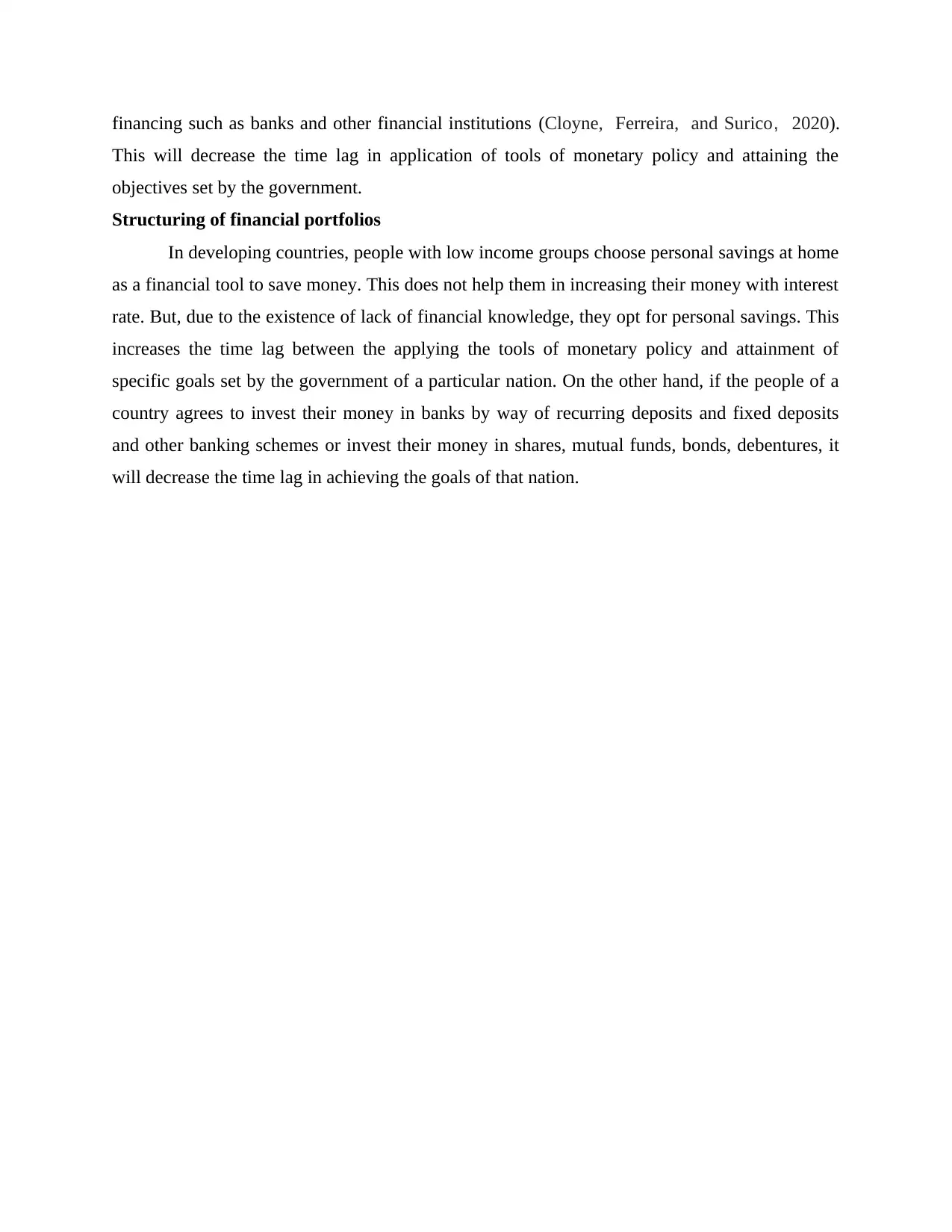
financing such as banks and other financial institutions (Cloyne, Ferreira, and Surico, 2020).
This will decrease the time lag in application of tools of monetary policy and attaining the
objectives set by the government.
Structuring of financial portfolios
In developing countries, people with low income groups choose personal savings at home
as a financial tool to save money. This does not help them in increasing their money with interest
rate. But, due to the existence of lack of financial knowledge, they opt for personal savings. This
increases the time lag between the applying the tools of monetary policy and attainment of
specific goals set by the government of a particular nation. On the other hand, if the people of a
country agrees to invest their money in banks by way of recurring deposits and fixed deposits
and other banking schemes or invest their money in shares, mutual funds, bonds, debentures, it
will decrease the time lag in achieving the goals of that nation.
This will decrease the time lag in application of tools of monetary policy and attaining the
objectives set by the government.
Structuring of financial portfolios
In developing countries, people with low income groups choose personal savings at home
as a financial tool to save money. This does not help them in increasing their money with interest
rate. But, due to the existence of lack of financial knowledge, they opt for personal savings. This
increases the time lag between the applying the tools of monetary policy and attainment of
specific goals set by the government of a particular nation. On the other hand, if the people of a
country agrees to invest their money in banks by way of recurring deposits and fixed deposits
and other banking schemes or invest their money in shares, mutual funds, bonds, debentures, it
will decrease the time lag in achieving the goals of that nation.
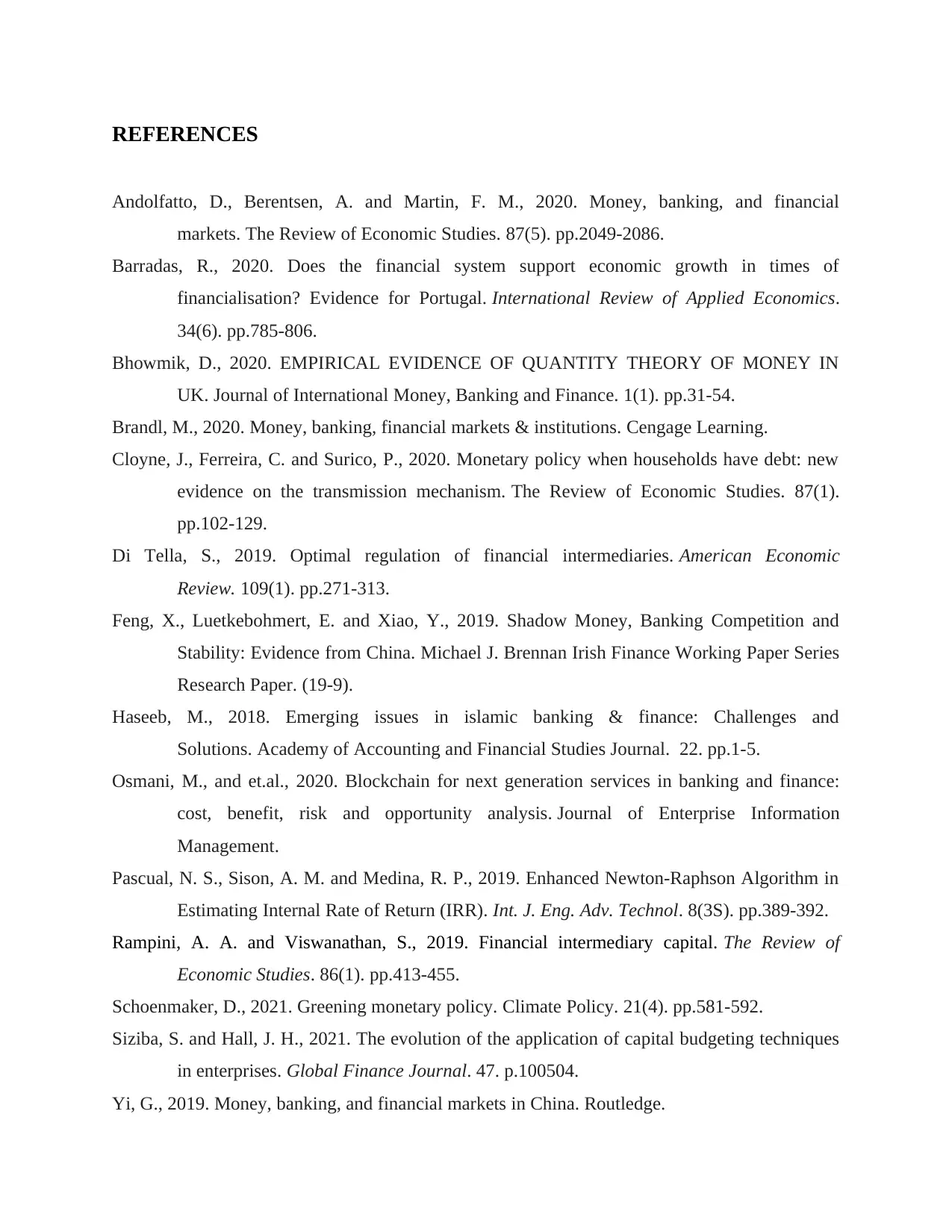
REFERENCES
Andolfatto, D., Berentsen, A. and Martin, F. M., 2020. Money, banking, and financial
markets. The Review of Economic Studies. 87(5). pp.2049-2086.
Barradas, R., 2020. Does the financial system support economic growth in times of
financialisation? Evidence for Portugal. International Review of Applied Economics.
34(6). pp.785-806.
Bhowmik, D., 2020. EMPIRICAL EVIDENCE OF QUANTITY THEORY OF MONEY IN
UK. Journal of International Money, Banking and Finance. 1(1). pp.31-54.
Brandl, M., 2020. Money, banking, financial markets & institutions. Cengage Learning.
Cloyne, J., Ferreira, C. and Surico, P., 2020. Monetary policy when households have debt: new
evidence on the transmission mechanism. The Review of Economic Studies. 87(1).
pp.102-129.
Di Tella, S., 2019. Optimal regulation of financial intermediaries. American Economic
Review. 109(1). pp.271-313.
Feng, X., Luetkebohmert, E. and Xiao, Y., 2019. Shadow Money, Banking Competition and
Stability: Evidence from China. Michael J. Brennan Irish Finance Working Paper Series
Research Paper. (19-9).
Haseeb, M., 2018. Emerging issues in islamic banking & finance: Challenges and
Solutions. Academy of Accounting and Financial Studies Journal. 22. pp.1-5.
Osmani, M., and et.al., 2020. Blockchain for next generation services in banking and finance:
cost, benefit, risk and opportunity analysis. Journal of Enterprise Information
Management.
Pascual, N. S., Sison, A. M. and Medina, R. P., 2019. Enhanced Newton-Raphson Algorithm in
Estimating Internal Rate of Return (IRR). Int. J. Eng. Adv. Technol. 8(3S). pp.389-392.
Rampini, A. A. and Viswanathan, S., 2019. Financial intermediary capital. The Review of
Economic Studies. 86(1). pp.413-455.
Schoenmaker, D., 2021. Greening monetary policy. Climate Policy. 21(4). pp.581-592.
Siziba, S. and Hall, J. H., 2021. The evolution of the application of capital budgeting techniques
in enterprises. Global Finance Journal. 47. p.100504.
Yi, G., 2019. Money, banking, and financial markets in China. Routledge.
Andolfatto, D., Berentsen, A. and Martin, F. M., 2020. Money, banking, and financial
markets. The Review of Economic Studies. 87(5). pp.2049-2086.
Barradas, R., 2020. Does the financial system support economic growth in times of
financialisation? Evidence for Portugal. International Review of Applied Economics.
34(6). pp.785-806.
Bhowmik, D., 2020. EMPIRICAL EVIDENCE OF QUANTITY THEORY OF MONEY IN
UK. Journal of International Money, Banking and Finance. 1(1). pp.31-54.
Brandl, M., 2020. Money, banking, financial markets & institutions. Cengage Learning.
Cloyne, J., Ferreira, C. and Surico, P., 2020. Monetary policy when households have debt: new
evidence on the transmission mechanism. The Review of Economic Studies. 87(1).
pp.102-129.
Di Tella, S., 2019. Optimal regulation of financial intermediaries. American Economic
Review. 109(1). pp.271-313.
Feng, X., Luetkebohmert, E. and Xiao, Y., 2019. Shadow Money, Banking Competition and
Stability: Evidence from China. Michael J. Brennan Irish Finance Working Paper Series
Research Paper. (19-9).
Haseeb, M., 2018. Emerging issues in islamic banking & finance: Challenges and
Solutions. Academy of Accounting and Financial Studies Journal. 22. pp.1-5.
Osmani, M., and et.al., 2020. Blockchain for next generation services in banking and finance:
cost, benefit, risk and opportunity analysis. Journal of Enterprise Information
Management.
Pascual, N. S., Sison, A. M. and Medina, R. P., 2019. Enhanced Newton-Raphson Algorithm in
Estimating Internal Rate of Return (IRR). Int. J. Eng. Adv. Technol. 8(3S). pp.389-392.
Rampini, A. A. and Viswanathan, S., 2019. Financial intermediary capital. The Review of
Economic Studies. 86(1). pp.413-455.
Schoenmaker, D., 2021. Greening monetary policy. Climate Policy. 21(4). pp.581-592.
Siziba, S. and Hall, J. H., 2021. The evolution of the application of capital budgeting techniques
in enterprises. Global Finance Journal. 47. p.100504.
Yi, G., 2019. Money, banking, and financial markets in China. Routledge.
⊘ This is a preview!⊘
Do you want full access?
Subscribe today to unlock all pages.

Trusted by 1+ million students worldwide
1 out of 16
Related Documents
Your All-in-One AI-Powered Toolkit for Academic Success.
+13062052269
info@desklib.com
Available 24*7 on WhatsApp / Email
![[object Object]](/_next/static/media/star-bottom.7253800d.svg)
Unlock your academic potential
Copyright © 2020–2025 A2Z Services. All Rights Reserved. Developed and managed by ZUCOL.



